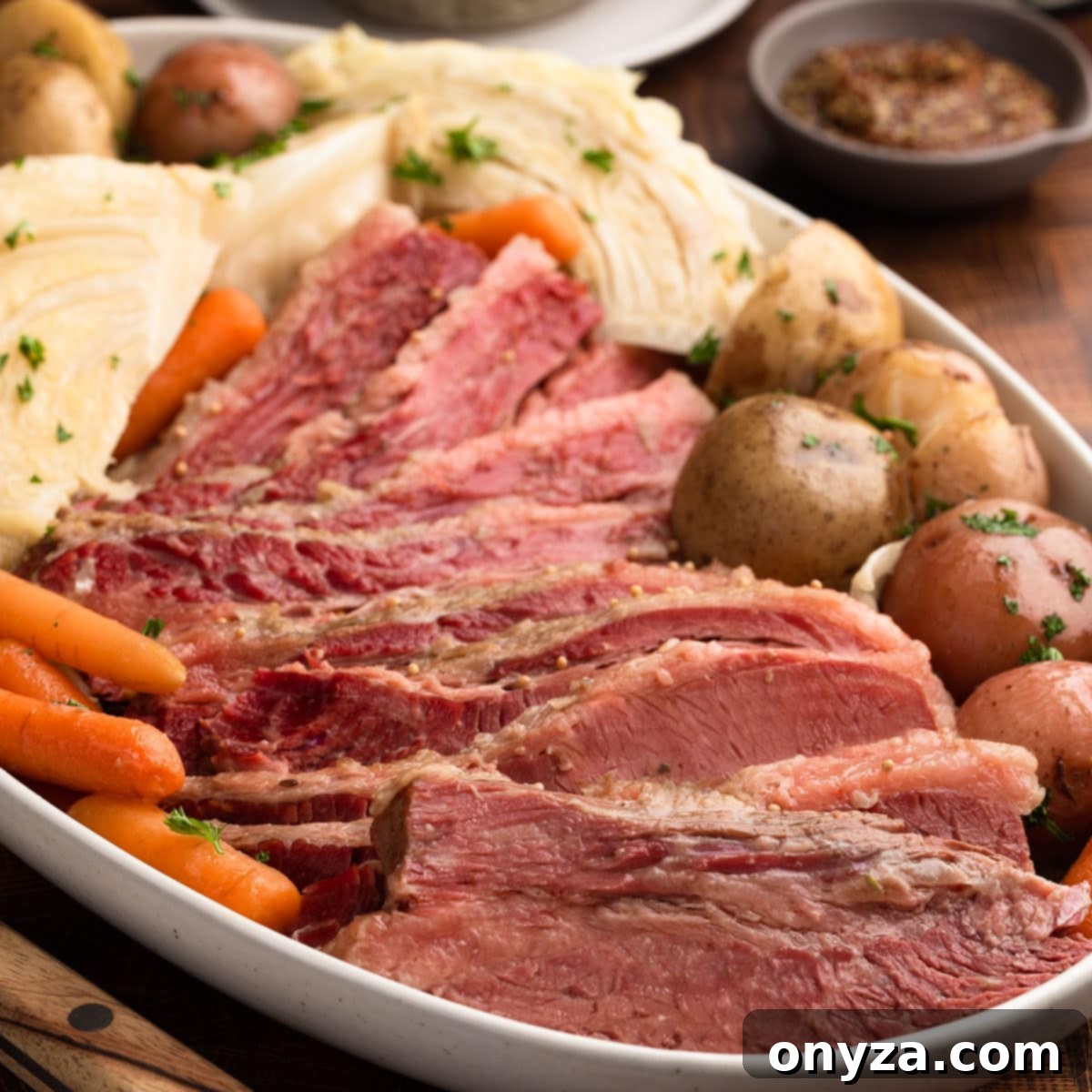Welcome to the ultimate guide for preparing a truly unforgettable Slow Cooker Corned Beef and Cabbage. This classic dish, renowned for its tender, fall-apart texture and rich, savory flavor, is a staple for St. Patrick’s Day celebrations and a comforting meal any time of the year. The secret to achieving perfectly succulent corned beef lies in the ‘low and slow’ cooking method, which tenderizes the meat to perfection while infusing it with aromatic spices, a hint of beer, and the wholesome goodness of potatoes, carrots, and cabbage.
Forget dry, tough brisket. Our recipe ensures a meltingly tender result that will impress your family and friends. By utilizing the convenience of a slow cooker, this dish becomes largely hands-off, allowing you to focus on other preparations or simply relax while your kitchen fills with an irresistible aroma. We’ll guide you through each step, from selecting the right cut of corned beef to achieving perfectly cooked vegetables, all in one pot.
Exploring other corned beef preparations? Discover more reader-favorite recipes like our Beer Braised Corned Beef with Whiskey Mustard Glaze (prepared in a Dutch oven), or the speedy Instant Pot Corned Beef and Cabbage (using an electric pressure cooker).
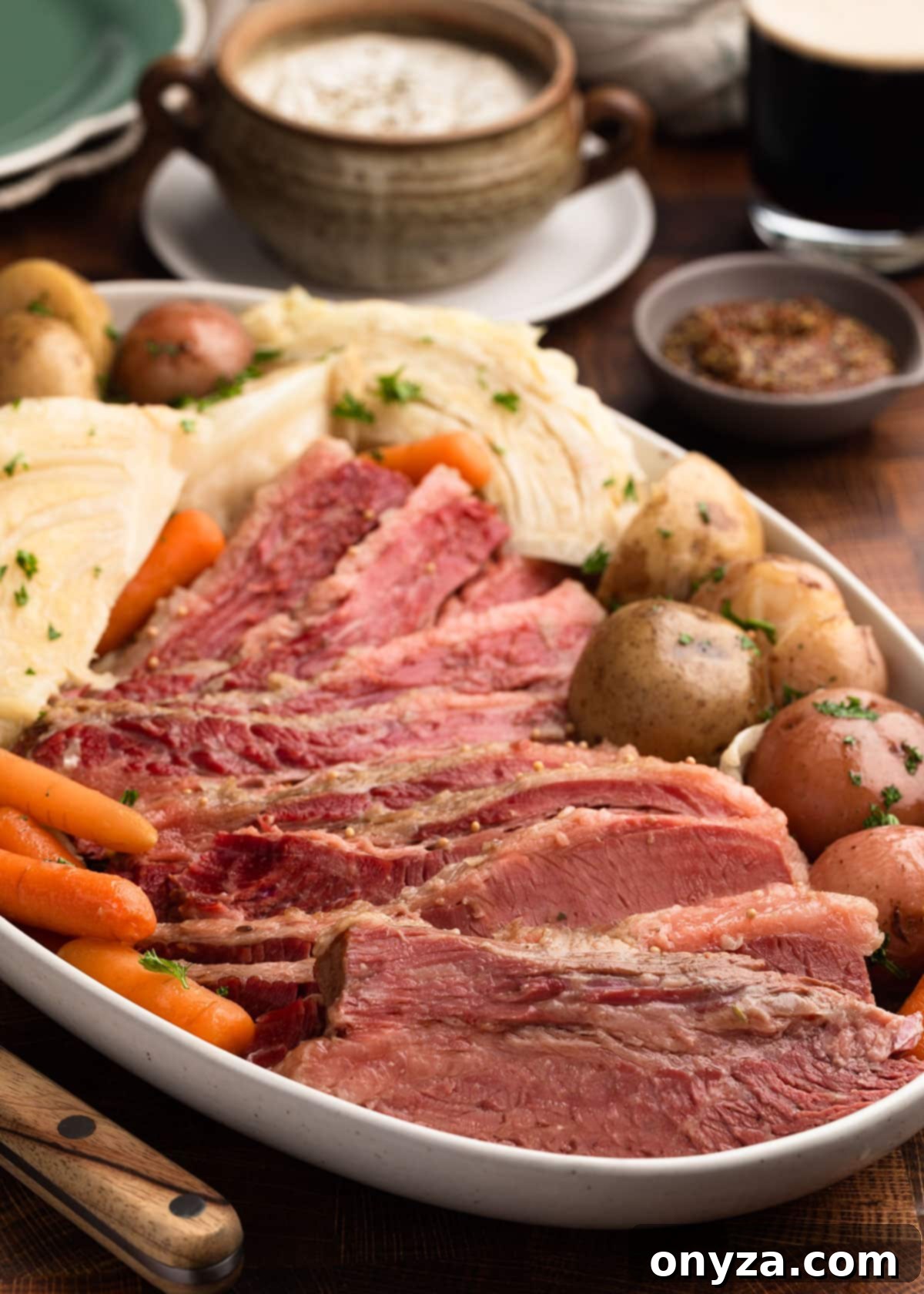
Essential Tips Before You Begin Cooking
- This Slow Cooker Corned Beef and Cabbage recipe is designed for maximum ease, requiring only about 10 minutes of active preparation time before your slow cooker takes over. Aside from two simple steps to incorporate the vegetables, it truly is a set-it-and-forget-it meal, perfect for busy schedules.
- To comfortably accommodate the corned beef, potatoes, carrots, and cabbage for a complete one-pot meal, we highly recommend using a large slow cooker, ideally 6 to 7 quarts in capacity. This ensures all ingredients fit without overcrowding, allowing them to cook evenly and absorb the rich flavors.
- Plan for a lengthy cooking time of 8 to 10 hours on the LOW heat setting. While some recipes might suggest cooking corned beef on high heat, we strongly advise against it. Higher temperatures can cause the brisket to become tough and stringy, compromising its desired tender texture. A slow, gentle simmer is crucial for breaking down the collagen in the meat, resulting in exceptionally tender, moist, and flavorful corned beef that practically melts in your mouth.
Crafting the Perfect Slow Cooker Corned Beef and Cabbage
For this delightful recipe, you will need a “flat cut” corned beef brisket, weighing approximately 4 to 5-1/2 pounds. The flat cut is generally preferred for its uniform thickness, which allows for even cooking and easier slicing. Ensure your brisket has a noticeable fat cap, as this is essential for contributing moisture and enhancing the overall flavor profile during the long cooking process.
Before introducing the corned beef to your slow cooker, it’s always a good practice to rinse it thoroughly under cool, running water. This simple step helps to remove any excess brine or salt solution from the packaging, preventing your finished brisket from being overly salty and ensuring a balanced flavor in the final dish.
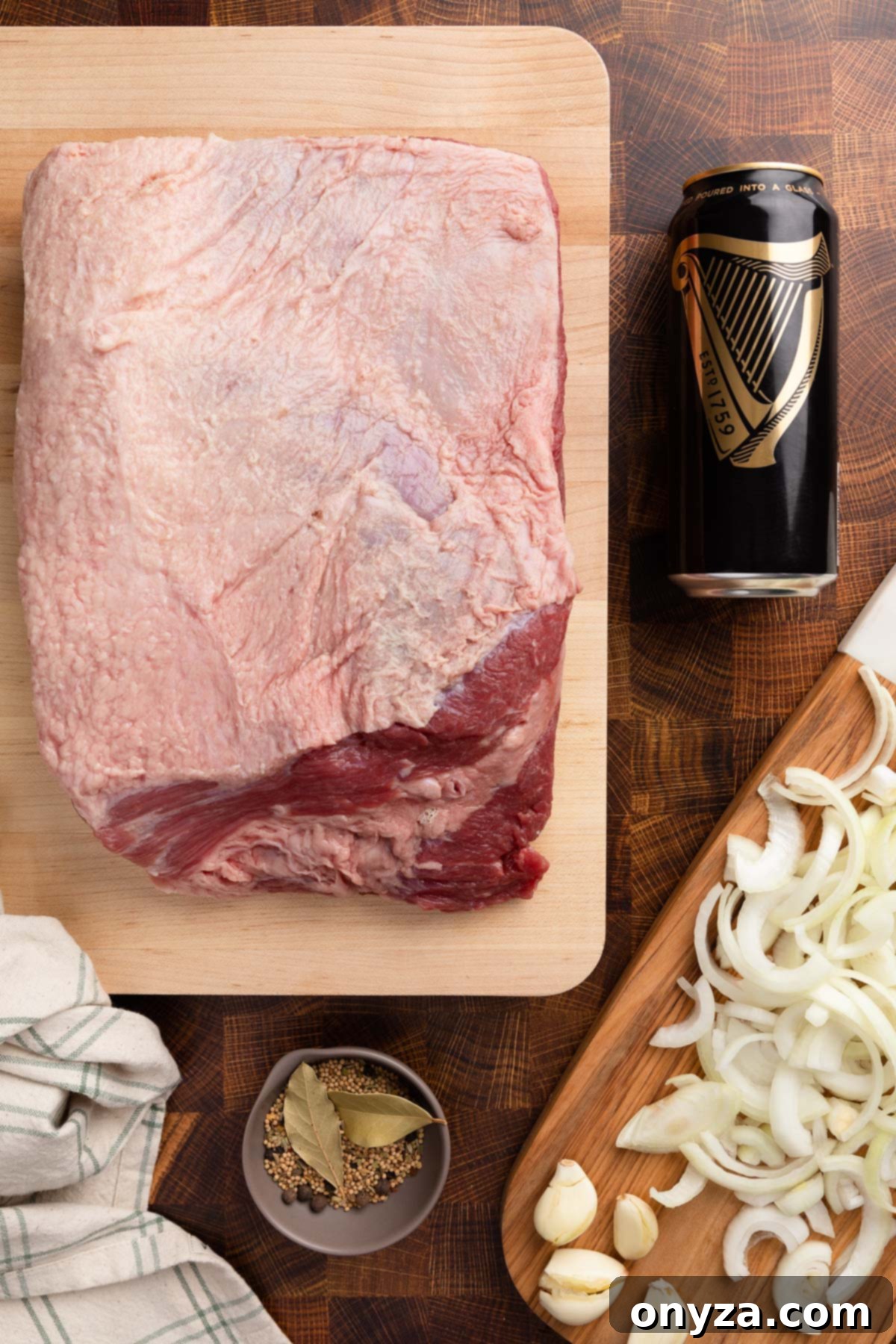
Step 1: Layer the Foundation of Flavor
Begin by creating a flavorful base in your slow cooker. Spread a generous layer of thinly sliced yellow onions and whole garlic cloves, peeled and lightly smashed, across the bottom. These aromatics will slowly release their sweet and pungent notes, infusing the cooking liquid and ultimately the meat with incredible depth. Next, evenly sprinkle half of the seasoning packet that typically accompanies your corned beef over the onions. If your brisket doesn’t come with a packet, use about 1 tablespoon of pickling spices instead.
Carefully place the rinsed corned beef brisket on top of the onion and garlic base, ensuring the fat cap is facing upwards. This strategic placement allows the fat to slowly render and baste the meat as it cooks, keeping it incredibly moist and adding richness. Sprinkle the remaining seasoning packet or pickling spices over the brisket, and then add a dried bay leaf (or two small ones if preferred) to the liquid for an additional layer of herbaceous aroma.


Pour 1 cup of your chosen beer over the brisket. Beer not only contributes a wonderful depth of flavor to the cooking liquid but also aids in tenderizing the meat, thanks to its natural enzymes. Following the beer, add enough cool water to fully submerge the corned beef. The precise amount of water needed will vary depending on the size and shape of your brisket, typically ranging between 2 and 4 cups. For instance, the 5-1/2 pound brisket shown here required approximately 4 cups of water.
Don’t be concerned if your brisket has an irregular shape and a small portion of the fat cap peeks out from the liquid. The most important aspect is ensuring that the meat itself is largely covered, allowing it to braise effectively in the flavorful liquid.
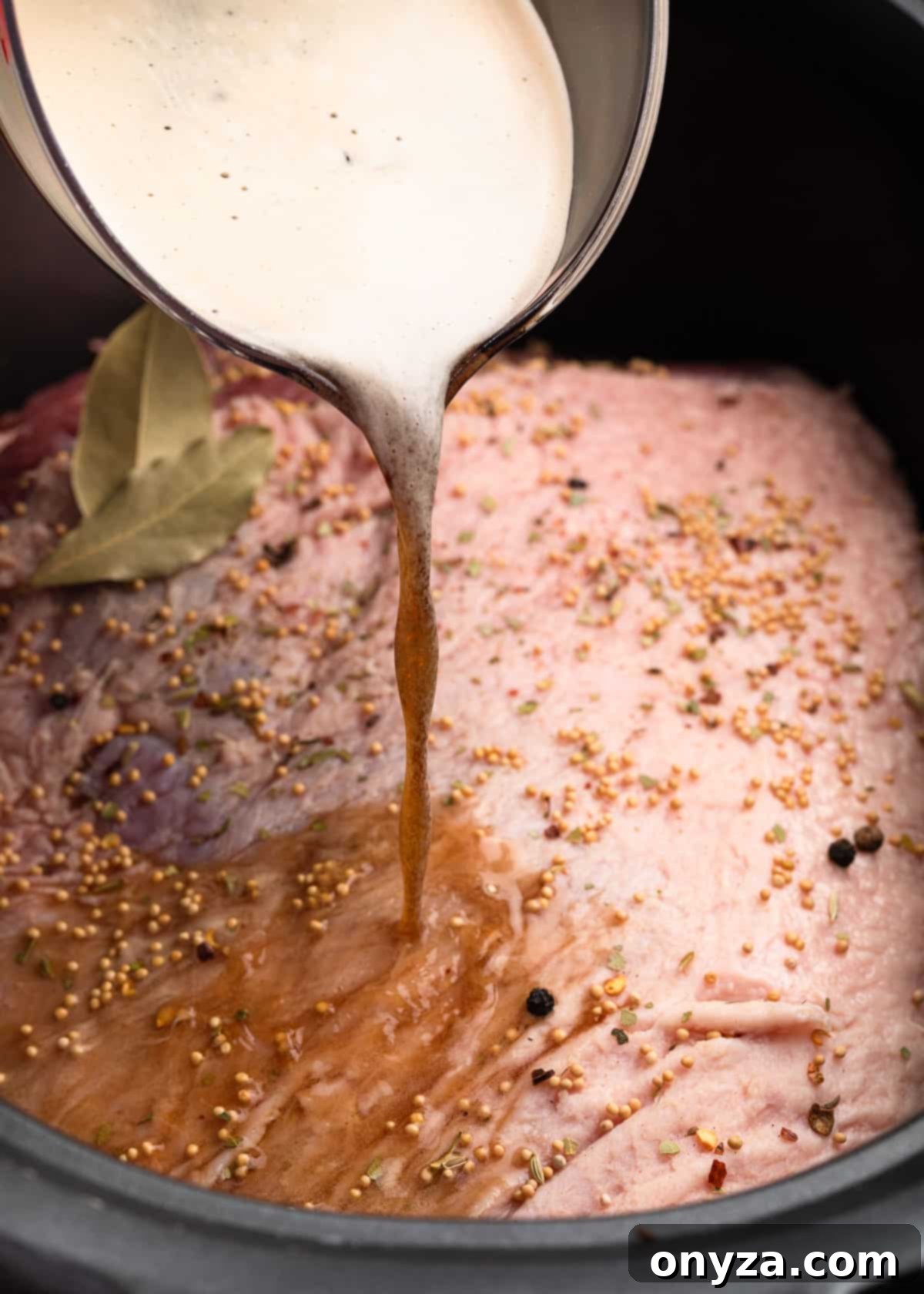

Tip for Beer Selection: While beer significantly enhances the flavor and tenderness of corned beef, it’s crucial to choose wisely. Avoid overly hoppy or intensely bitter beers, as these can impart an undesirable flavor to your brisket.
If you’re opting for a stout, we highly recommend Guinness Draught, which offers a smoother, less bitter profile compared to “Extra Stout.” Murphy’s Irish Stout is another excellent, mellow choice. For those who prefer a more subtle beer flavor, a lager-style beer works beautifully—our top pick for corned beef is Samuel Smith Pure Brewed Organic Lager.
Prefer to omit the beer? No problem! You can easily substitute the beer with an equal amount of unsalted beef broth or stock for a equally delicious, non-alcoholic option.
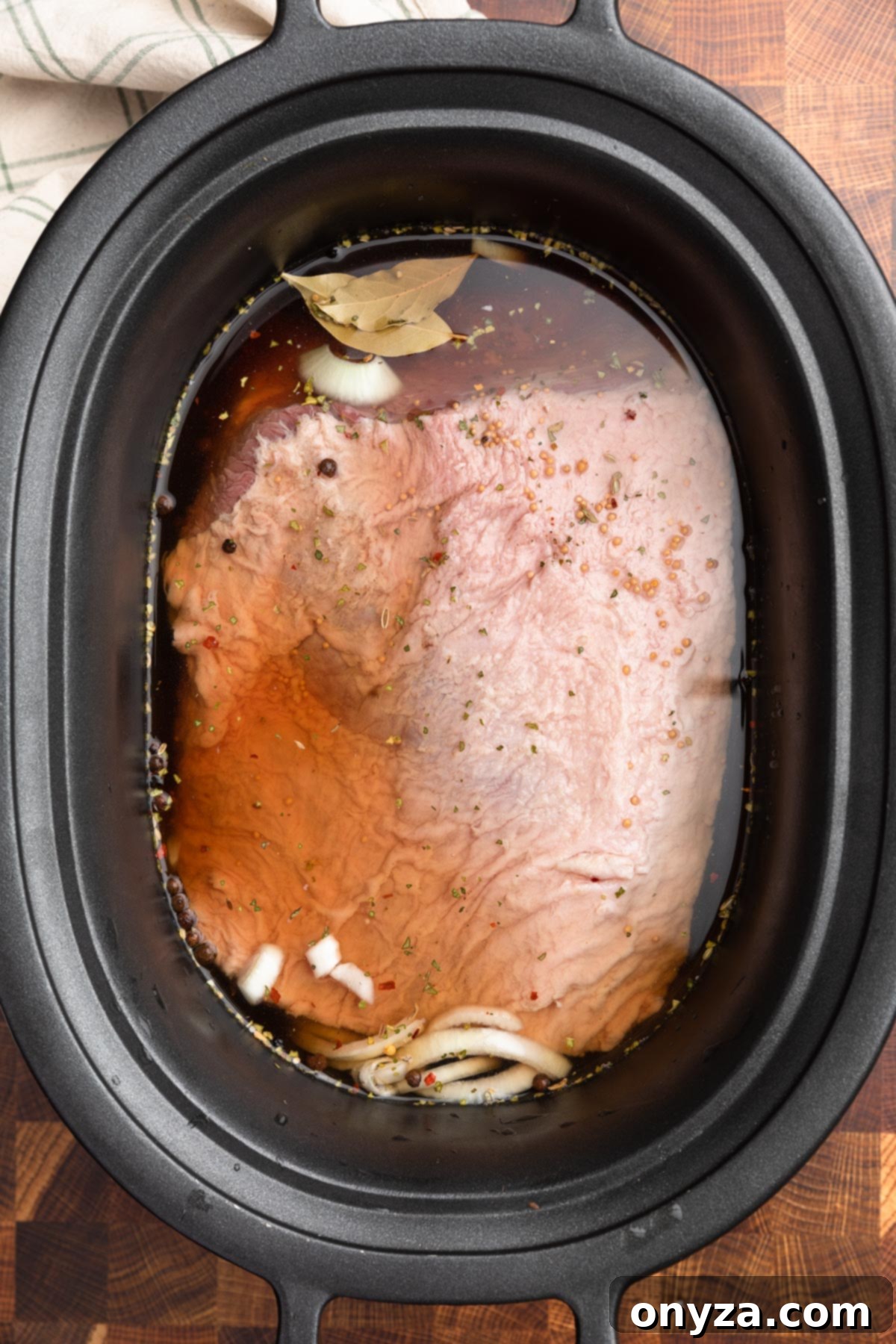
Step 2: The Art of Slow Cooking the Corned Beef
Once your ingredients are nestled perfectly in the slow cooker, the hardest part is over. Cover your slow cooker securely and set it to the LOW heat setting for 8 to 10 hours. The exact cooking duration will depend on the size of your corned beef brisket and your preferred final texture. Remember, the ‘low and slow’ method is key here, allowing the tough connective tissues in the brisket to gently break down over time, resulting in that coveted tender, juicy meat.
For a corned beef that is wonderfully tender yet still holds together well for slicing, we found that 9 hours on LOW was the ideal sweet spot for a 5-1/2 pound brisket. If you prefer a corned beef with more of a fall-apart or shredded consistency, simply extend the cooking time to the full 10 hours. For smaller briskets, around 4 pounds, start checking for doneness at the 8-hour mark.
The ultimate test for perfectly cooked corned beef is its tenderness: you should be able to effortlessly slide a fork in and out of the brisket without any resistance. This indicates that the collagen has fully broken down, yielding a remarkably tender piece of meat.
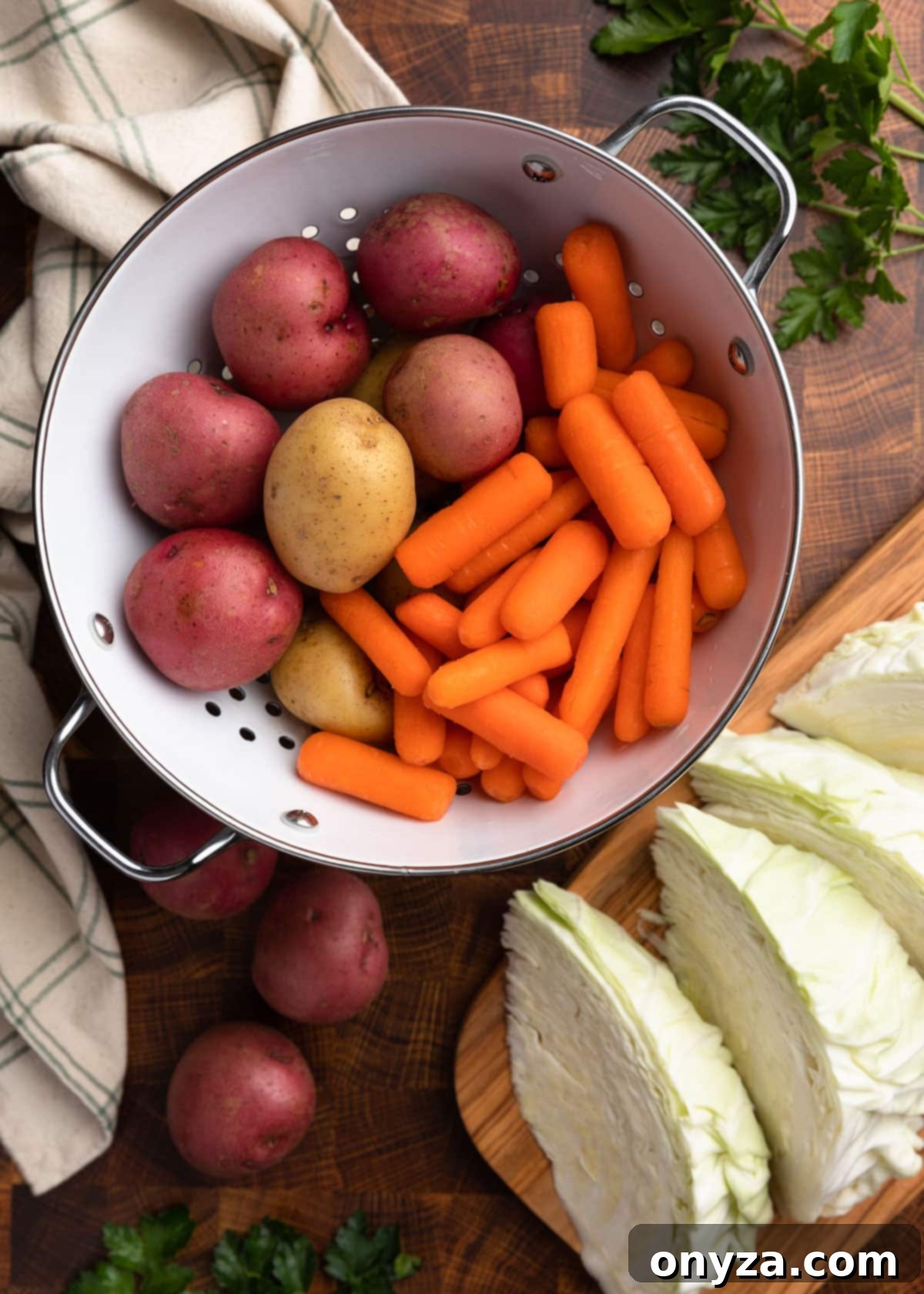
Step 3: Adding the Hearty Potatoes and Carrots
This recipe is designed to create a convenient one-pot corned beef dinner, complete with tender vegetables. However, a common mistake is adding the vegetables too early, which can lead to them becoming overcooked and mushy by the time the corned beef is done. To prevent this, we add the vegetables at a specific point in the cooking process.
After the corned beef has been cooking for approximately 3 hours, it’s time to introduce the root vegetables:
- Potatoes: We recommend using baby red and/or golden potatoes, ideally 1-1/2 to 2 inches in diameter. These thin-skinned varieties require no peeling, saving you prep time. If using larger potatoes, simply cut them into uniform 1-1/2 to 2-inch chunks to ensure even cooking.
- Carrots: For ultimate convenience, a bag of baby-cut carrots works perfectly. Alternatively, you can use 4-5 large carrots, peeled and cut into 2-inch lengths.
Since the slow cooker is set to LOW, these vegetables will require about 5-6 hours of cooking time to reach a soft, fork-tender texture. Gently nestle the potatoes and carrots around the brisket, doing your best to submerge them in the savory cooking liquid. This ensures they absorb all the incredible flavors while cooking thoroughly. Replace the lid on the slow cooker and allow everything to continue cooking for several more hours, until it’s time to add the cabbage.
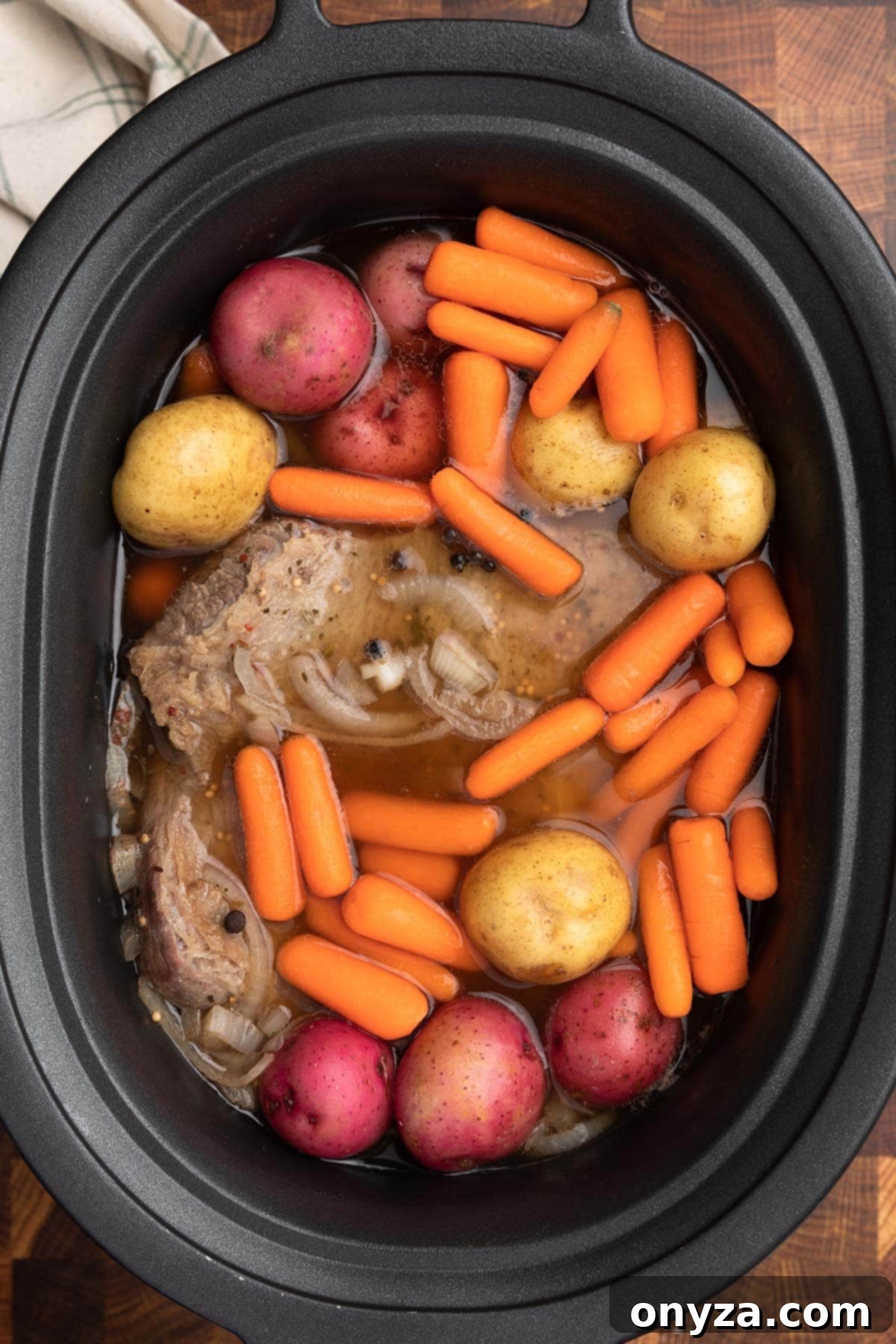
Step 4: Incorporating the Cabbage to Perfection
For the cabbage, select a medium-sized head and cut it into 6 to 8 wedges. It’s helpful to keep a portion of the core intact on each wedge, as this helps the pieces hold their shape during cooking and prevents them from falling apart. (If you need a visual guide, resources like “How to Cut a Head of Cabbage into Wedges” can be found on culinary websites.)
Similar to the potatoes and carrots, cabbage will become overly soft and lose its desirable texture if added too early in the slow cooking process. The timing of when you add the cabbage depends entirely on your preferred level of tenderness:
- For very soft, meltingly tender cabbage: Add the wedges to the slow cooker with 3 hours of the total cooking time remaining.
- For soft and tender cabbage that still retains some structure: This is our family’s favorite. Add the cabbage wedges with 2 hours of cooking time left.
- For crisp-tender cabbage with a slight bite: Introduce the cabbage during the last hour of cooking.
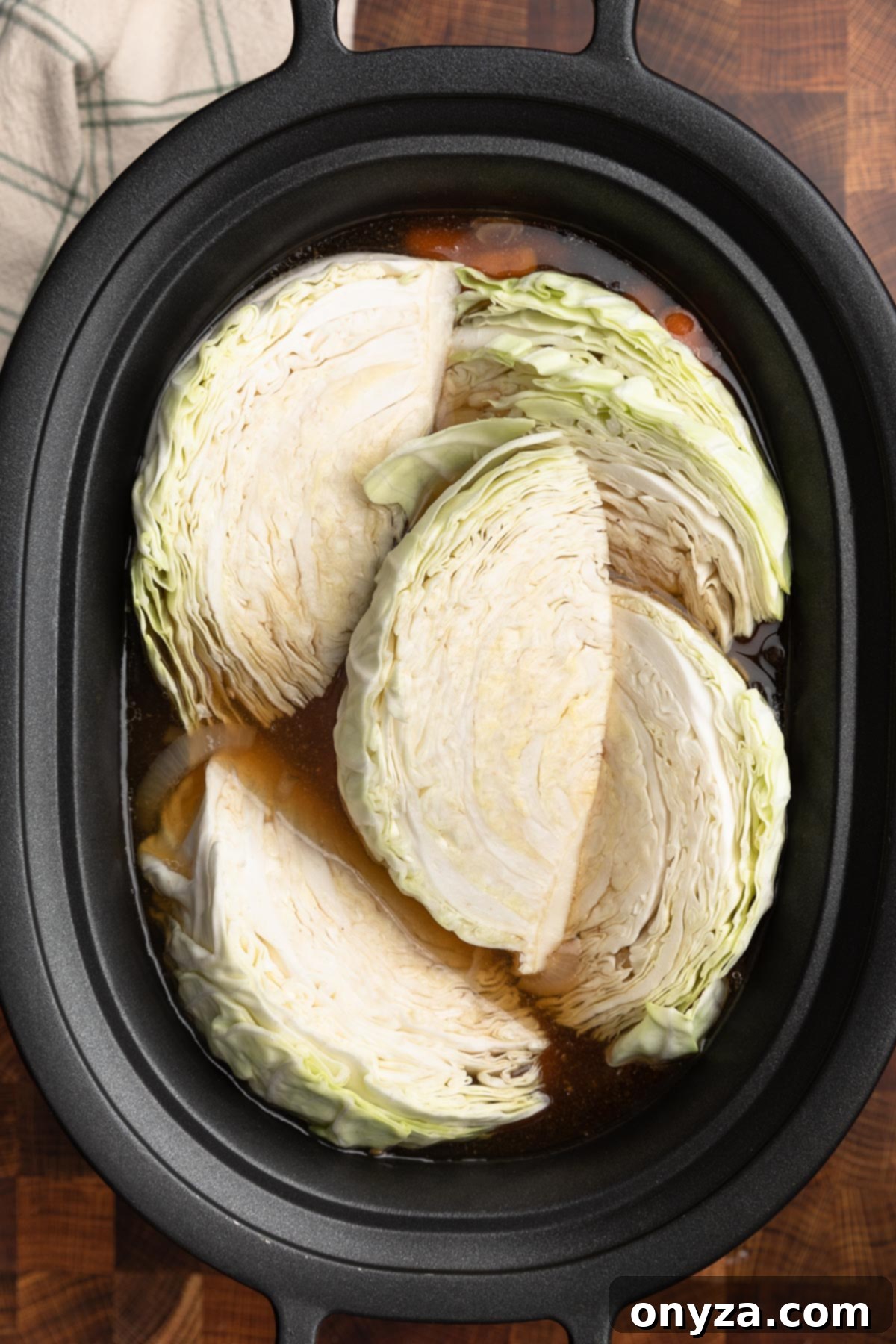
Don’t be surprised if your slow cooker looks quite full after adding the cabbage wedges. As long as the lid can fit securely and create a tight seal, there’s no need for concern. The cabbage will soften and wilt down as it cooks. However, depending on the specific size of your brisket and slow cooker, you might need to adjust the amount of cabbage you add. For instance, in the pictured dinner, we could only comfortably fit 5 out of 6 wedges.
No room in the slow cooker for cabbage? Consider an alternative preparation method! Roasting cabbage creates beautiful caramelized, crispy edges that add a fantastic dimension of flavor to your corned beef dinner. Try our recipe for Roasted Cabbage Wedges.
Another delicious option is to skip cooking the potatoes and cabbage in the slow cooker entirely and serve your corned beef with a side of Colcannon, a traditional Irish mashed potato dish. Our version incorporates sautéed cabbage and leeks for a truly hearty and flavorful accompaniment.
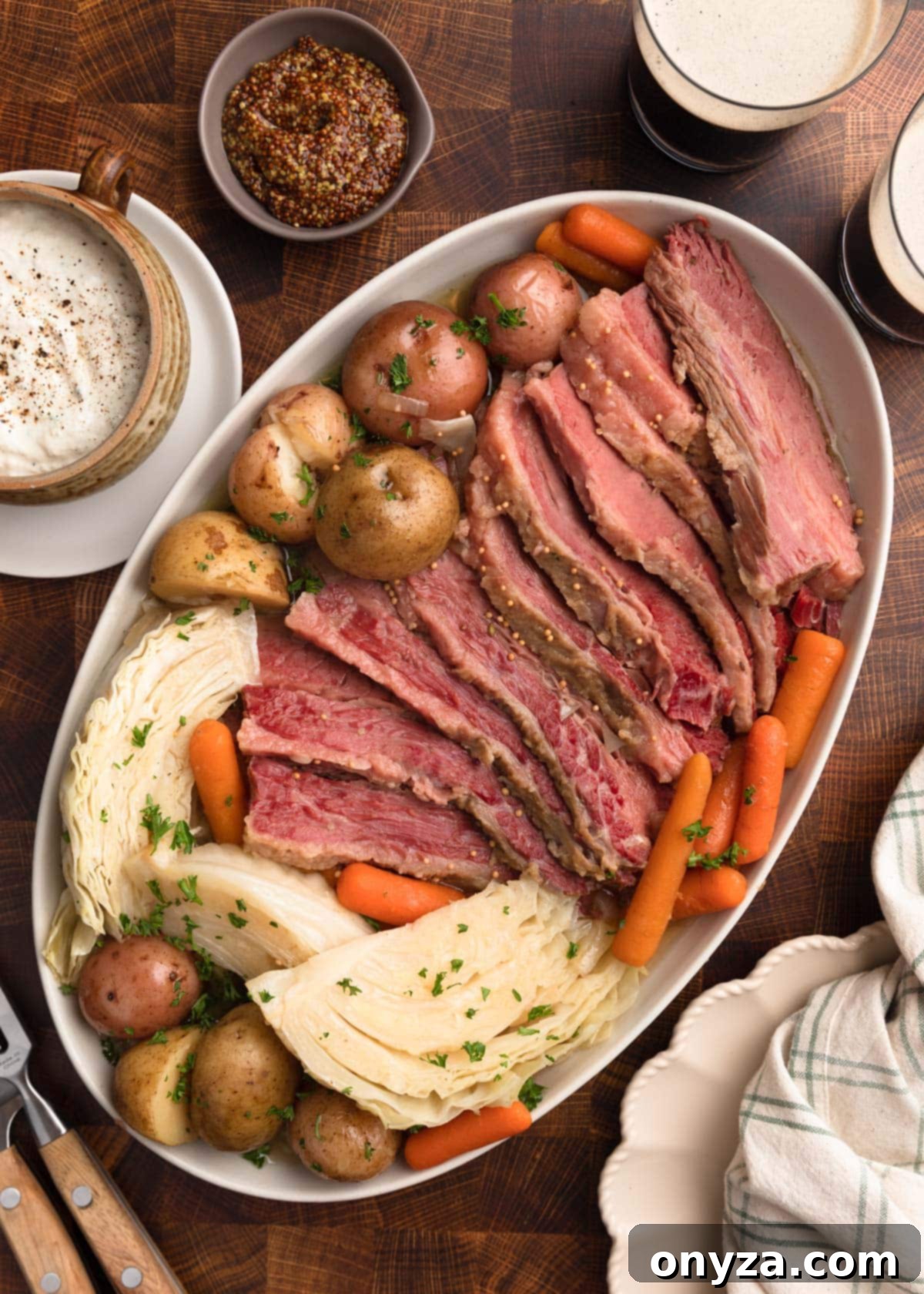
Serving Your Delicious Slow Cooker Corned Beef Dinner
Once the long, slow cooking process is complete—and your kitchen is filled with an absolutely incredible aroma—it’s time to prepare your meal for serving. The final steps are crucial for ensuring the best possible texture and presentation.
- Rest the Meat: Carefully transfer the cooked corned beef brisket from the slow cooker to a clean cutting board. Tent it loosely with aluminum foil and allow it to rest for approximately 10 minutes before slicing. This resting period is vital, as it allows the juices within the meat to redistribute, resulting in a more tender and juicy slice. Skipping this step can lead to a drier, less flavorful brisket.
- Keep the Vegetables Warm: While the corned beef rests, remove the tender cabbage wedges, potatoes, and carrots from the slow cooker. Arrange them on a separate serving platter or in a large bowl and also tent them with foil to keep them warm until ready to serve.
The vegetables will have absorbed wonderful flavors from the rich cooking liquid, but for an extra touch of indulgence and visual appeal, we like to dress them with a drizzle of melted butter, a generous grind of fresh black pepper, and a sprinkle of chopped fresh parsley for garnish. Depending on the inherent saltiness absorbed from the corned beef’s brine, they might also benefit from a pinch or two of additional salt, tasted to your preference.
To expertly slice the corned beef, first, trim the fat cap to your liking. Some prefer to leave a little for added flavor, while others opt for a leaner cut. Then, using a sharp carving knife, slice the meat against the grain. This is perhaps the most important tip for tender slices; cutting against the grain shortens the muscle fibers, making each bite much more tender and preventing the meat from shredding apart. Aim for slices that are about 1/4-inch thick.
For an extra boost of juiciness on the serving platter, we recommend straining a little of the cooking liquid from the slow cooker and drizzling it over the sliced corned beef. This keeps the meat moist and adds another layer of flavor. Some of our favorite accompaniments to complete this classic meal include:
- Mustard: A robust, whole grain mustard is a perfect pairing. We particularly enjoy Maille Old Style or Lakeshore Wholegrain Mustard with Irish Whiskey.
- Horseradish Sauce: The piquant kick of horseradish sauce beautifully complements the richness of corned beef. Try our recipes for Creamy Horseradish Sauce or Roasted Garlic Horseradish Sauce.
- Irish Soda Bread: A slice of warm, freshly baked Irish Soda Bread, slathered generously with rich Irish butter, is the quintessential side.
Storing and Repurposing Delicious Leftovers
Should you be fortunate enough to have leftovers from your Slow Cooker Corned Beef and Cabbage feast, they can be stored in an airtight container in the refrigerator for 3 to 4 days. To ensure the meat remains as juicy as possible, we suggest spooning a little of the strained cooking liquid over the slices before sealing the container.
Leftover corned beef is incredibly versatile and can be transformed into a variety of delicious meals. Some of our favorite ways to enjoy it include:
- Hearty Corned Beef Hash and Eggs for a satisfying breakfast or brunch.
- Classic Reuben Sandwiches, convenient Reuben Sliders, or a crowd-pleasing Reuben Dip.
- Simple yet flavorful Corned Beef Sandwiches with Creamy Coleslaw.
- Crispy and delicious Corned Beef and Potato Cakes.
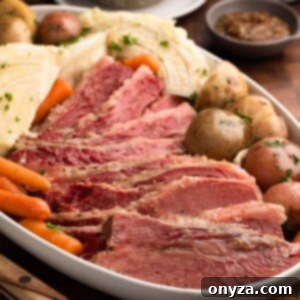
Slow Cooker Corned Beef and Cabbage
Amanda Biddle
Slow Cooker Corned Beef is reliably flavorful, tender, and juicy every time. Cook the potatoes, carrots, and cabbage alongside the brisket for a one-pot dinner that’s perfect for St. Patrick’s Day.
10 minutes
9 hours
10 minutes
9 hours 20 minutes
6 people
Ingredients
- 4 to 5-1/2 pound corned beef brisket (flat cut recommended), rinsed in cool water
- 1 large yellow onion, halved and cut into 1/4-inch slices
- 4 large garlic cloves, peeled and lightly smashed with the back of a chef’s knife
- 1 large dried bay leaf (or two small ones; see note)
- 2 tablespoons pickling spice (or the seasoning packet that came with your corned beef)
- 8 ounces beer (see note for recommendations or substitutions)
- 2-4 cups water, as needed to cover brisket
- 1-1/2 to 2 pounds baby potatoes (red or golden, 1-1/2 to 2-inches in diameter)
- 1 pound baby carrots (or 4-5 large carrots, peeled and cut into 2-inch lengths)
- 1 medium green cabbage, cut into 6-8 wedges
- Melted butter, chopped parsley, salt, and pepper, for garnishing the vegetables (optional)
- Whole grain mustard or horseradish sauce, for serving (optional)
Instructions
Cook the Brisket
- Place sliced onions and smashed garlic cloves in the bottom of a 6 to 7 quart slow cooker insert. Sprinkle with half of the seasoning packet or pickling spice. Lay the rinsed corned beef over the onions with the fat cap facing up. Sprinkle the remaining spice packet over the brisket.
- Pour the beer over the corned beef, followed by enough water to just cover the brisket. Add the bay leaf to the liquid. Place the lid on the slow cooker and set it to LOW heat for 8-10 hours. The corned beef is ready when you can easily slide a fork in and out of the center of the brisket without resistance.
Add the Potatoes and Carrots
- With 5-6 hours remaining on the total cooking time, add the potatoes and carrots to the slow cooker. Gently nestle them around the brisket, ensuring they are submerged in the cooking liquid where possible for even cooking and flavor absorption.
- Replace the lid on the slow cooker and continue cooking on LOW until it’s time to add the cabbage.
Add the Cabbage
- With 2 hours remaining in the total cooking time, add the cabbage wedges to the slow cooker. The insert will look very full, but this is acceptable as long as you can replace the slow cooker lid snugly. Cover the slow cooker and continue cooking on LOW for the remaining time.
- (Note on cabbage tenderness: 2 hours of cooking on LOW results in fork-tender cabbage. For very soft cabbage, add the wedges to the slow cooker with 3 hours remaining. For crisp-tender cabbage, add the wedges with only 1 hour remaining.)
Slice the Corned Beef and Serve
- Once everything is cooked, carefully remove the cabbage, potatoes, and carrots from the slow cooker. Place them on a serving platter or in a large bowl and tent with foil to keep warm.
- Remove the corned beef from the slow cooker and transfer it to a cutting board. Tent with foil and let it rest for 10 minutes. Trim the fat cap as desired, then use a sharp carving knife to slice the meat against the grain into approximately 1/4-inch slices for maximum tenderness.
- If desired, strain some of the cooking liquid and drizzle it over the sliced corned beef on the platter to keep it juicy. We love to drizzle the potatoes, carrots, and cabbage with melted butter, season to taste with salt and pepper, and garnish with fresh chopped parsley.
- Serve the corned beef and vegetables with your favorite whole grain mustard or creamy horseradish sauce (recipe links are in the notes below).
Notes
Bay Leaf: If your pickling spice blend or seasoning packet already contains a significant amount of cracked bay leaf, feel free to reduce the quantity of additional dried bay leaves or omit them entirely. Spice blends vary, so adjust accordingly.
Beer Selection: When using dark beers such as stout, opt for a variety with mild bitterness. Guinness Draught is an excellent choice, being less bitter than Guinness Extra Stout. Murphy’s Irish Stout is another smooth option that works wonderfully. For a lighter beer flavor profile, a lager is ideal—we recommend Samuel Smith’s Pure Brewed Organic Lager. If you prefer to skip alcohol, substitute the beer with an equal amount of unsalted beef broth or stock.
Vegetable Preparation: If using larger potatoes instead of baby potatoes, cut them into 1-1/2 to 2-inch wedges. Thin-skinned varieties typically do not require peeling. Similarly, if using regular carrots rather than baby carrots, peel and cut them into uniform 2-inch lengths.
Glazing Option: For those who enjoy a crispy, caramelized crust on their corned beef, consider glazing it after slow cooking. Simply follow the “Glaze and Serve” instructions provided in our Beer Braised Corned Beef with Whiskey Mustard Glaze recipe for a delicious finishing touch.
Recommended Serving Sauces: Enhance your meal with our homemade Creamy Horseradish Sauce or Roasted Garlic Horseradish Sauce.
Nutrition Estimate
Serving: 0.166 recipe | Calories: 425kcal | Carbohydrates: 27g | Protein: 26g | Fat: 23g | Saturated Fat: 7g | Polyunsaturated Fat: 1g | Monounsaturated Fat: 11g | Cholesterol: 82mg | Sodium: 1936mg | Potassium: 1110mg | Fiber: 7g | Sugar: 10g | Vitamin A: 10581IU | Vitamin C: 108mg | Calcium: 120mg | Iron: 4mg
Nutrition information is automatically calculated and should only be used as an approximation.
Please note that our recipes have been developed using the US Customary measurement system and have not been tested for high altitude/elevation cooking and baking.
Editor’s note: This recipe was initially published on Striped Spatula in February 2023. We have since updated the content with enhanced details and clarified instructions to address common reader questions and improve the overall cooking experience.
